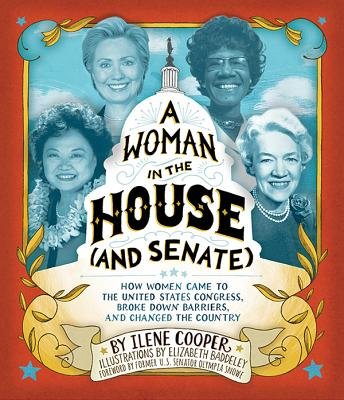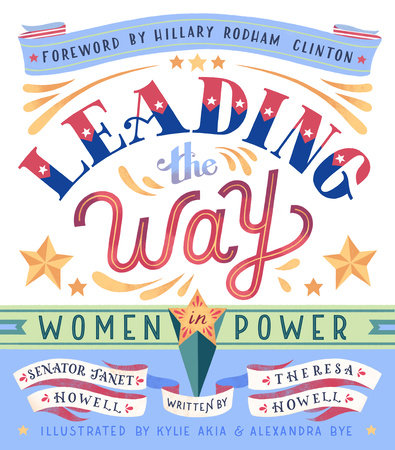Women in Congress: 14 Political Pioneers to Introduce to Kids
by Ilene Cooper
“For the work of a day, / for the taxes we pay / for the laws we obey, / We want something to say!”
That little poem appeared in a political cartoon as women were trying to get the right to vote.
What? There was a time when American women weren’t allowed to vote? Yes, it was not until 1920 that the 19th amendment to the U.S Constitution was passed. It said, “The right of citizens of the United States to vote shall not be denied or abridged by the United States or by any State on the basis of sex.”
But there were some places in the United States where women could vote locally. Out West, pioneer women often faced the same hardships as men and felt they deserved the same rights and privileges. Rugged individualists of both sexes brought the vote to some of the Western states and territories while their Eastern sisters still fought to put their check on the ballots. Wyoming, which had given its women the vote in 1869, became a state in 1890 — the first with voting women.
Then, a little over 100 years ago, in 1916, four years before the passage of the 19th amendment, the citizens of Montana did something unheard of. They voted to send a woman to the U.S. Congress. Her name was Jeanette Rankin.

The day Jeanette Rankin took her oath of office was filled with drama, and not only because a representative was going to be called “congresswoman.” March 5, 1917 was also the day the Congress started discussions on whether to enter World War I.
Rankin was a pacifist — she hated war. Her vote was no. Even though she had made her views known during the campaign, many of her constituents back in Montana weren’t happy about her vote. She was not reelected to Congress in 1918.
Then, after decades working for causes she believed in like women’s rights and the peace movement, she was voted back into Congress in 1940, when entry into World War II was being debated. Most Americans wanted to stay out — until Japan attacked Pearl Harbor on December 7, 1941. Congress was asked by the president for a declaration of war.
Only one person voted against it. Jeanette Rankin.
Her unpopular vote once again ensured she would not be reelected to Congress. But Rankin remained a pacifist. On January 15, 1968, at age 87, she led 5,000 women through the streets of Washington D.C. to protest the war in Vietnam.
When she first entered the Congress in 1917, Jeannette Rankin said “I may be the first woman member of Congress, but I won’t be the last!”
And she wasn’t. In the 1920s, most of the women who came to Congress got there because of a connection to the men in their lives, appointed to finish their late husbands’ or fathers’ terms in office. Some went on to win new elections on their own. Some stayed for decades. One stayed for only a day!
Rebecca Felton was the first woman senator. She was 87 years old when she got the call. In 1922, one of Georgia’s senators died. The governor wanted that Senate seat for himself, but he needed someone who’d hold it until a special election. When Felton was sworn in, Congress was in recess. She only spent one day in office before the winner of the special election took over — and it wasn’t the governor.

There were other firsts as the decades rolled on. In 1947, Margaret Chase Smith, a House representative from Vermont, decided to run for the state’s open Senate seat. She won with 71 per cent of the vote. She was the first woman to win a Senate seat without being appointed or having a husband sitting in it first. Smith had a long and storied career, serving in the Senate until 1972. In 1988 President George H.W. Bush awarded her the Presidential Medal of Freedom, which recognizes people who’ve made special contributions to the United States.

Up until 1965, there were no women of color in the U.S. Congress. That “first” went to Patsy Mink. A lawyer of Japanese descent from Hawaii, Mink served in the U.S. House for 12 years in her first go-around. After some time away from Washington D.C., she returned to the House in 1990 and served until her death in 2002.

Shirley Chisholm, elected to the House in 1968, was not just the first African American woman to serve in Congress, she was the first to run for president. She knew she couldn’t win. But she felt strongly the political landscape in America needed change and color. She wanted to speak for the poor, minorities, and those against the Vietnam War. At the Democratic convention, she received 152 delegate votes, which she claimed as a symbolic victory.

In 1989, Ileana Ros-Lehtinen was the first Hispanic American woman to serve in the House of Representatives. Her family had escaped Communist Cuba in 1968, when she was eight. She is still serving in Congress.

In 1992, California became the first state to have two women senators, Diane Feinstein and Barbara Boxer. Later in the decade, on the opposite side of the country, the state of Maine had two women serving the Senate, Olympia Snowe and Susan Collins.


It was another Californian, Nancy Pelosi, who in 2007 became the first woman Speaker of the House of Representatives. If something were to happen to the President and Vice President, the Speaker is the next in line for the presidency. The Speakership is also one of the most influential jobs in the country.

In 2016, 100 years after the first woman was elected to Congress, a former senator from New York (and former First Lady), Hillary Clinton, ran to become the first woman president of the United States. Though she lost the 2016 election, the nomination was still historic and a step in the right direction for women in politics.

Alexandria Ocasio-Cortez (commonly known as AOC) assumed office in the House of Representatives in 2019, making her the youngest woman to ever serve in the United States Congress at the age of 29. AOC advocates for progressive platforms and is apart of a new generation of political leaders.

Kamala Harris, United States senator from California, made history in 2020 when she was named as presidential nominee Joe Biden’s VP — becoming the first African American, first Asian American, and third female vice presidential running mate on a major party ticket. If Joe Biden and Kamala Harris win the 2020 election, she’ll be the first female vice president.

It took 100 years for women to go from first serving in Congress to being the first female candidate for president from a major political party. Let’s hope the pace of progress quickens for the next generation of women in politics who have these trailblazers to thank for bringing us to where we are today.
-
Related Kids' Books:
-
Shirley Chisholm Is a Verb
Also available from:The Truths We Hold
Also available from:Who Is Hillary Clinton?
Also available from: -
Superheroes Are Everywhere
Also available from:Who Is Alexandria Ocasio-Cortez?
Also available from:Who Is Kamala Harris?
Also available from:
Editor’s Note: This article was originally published in 2016 and updated in 2020 by the Brightly Editors to add Alexandria Ocasio-Cortez and Kamala Harris.








